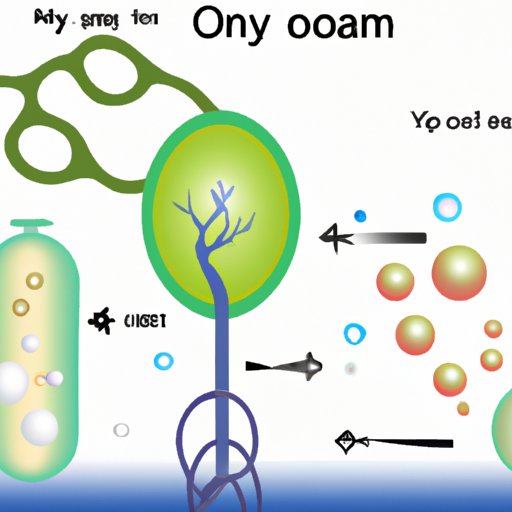Introduction
Oxygen is essential for all forms of life on Earth as it facilitates respiration and other vital processes. Knowing what produces the most oxygen can help us to understand how our environment is sustained, and how we can best take care of our planet. In this article, we’ll explore the natural sources of oxygen production, their significance within the ecosystem, and the benefits they provide.
Exploring the Natural Sources of Oxygen Production
The main sources of oxygen production are plant life, algae, bacteria, and microorganisms. Let’s take a closer look at each one.
Plant Life
Plants are essential for oxygen production. They produce oxygen through a process known as photosynthesis, which occurs when sunlight interacts with chlorophyll and other pigments in the leaves. This process breaks down water molecules into hydrogen and oxygen atoms, releasing oxygen into the atmosphere. Plants are the most efficient producers of oxygen, with one acre of trees producing enough oxygen for 18 people per year.
Benefits of Plants in Producing Oxygen
Plants are not only an important source of oxygen but also play a key role in air purification as they absorb carbon dioxide from the atmosphere. Additionally, plants help to regulate temperatures by providing shade and cooling through transpiration. Finally, they also provide food and shelter for a variety of wildlife species.
How Photosynthesis Generates Oxygen
Photosynthesis is the process by which plants convert light energy into chemical energy. It involves the absorption of light energy by pigments, such as chlorophyll, which then converts the energy into glucose molecules. During this process, oxygen is released as a byproduct. The glucose molecules produced are used by the plant as energy for growth and development.
Algae
Algae are aquatic organisms that are capable of photosynthesis. They are found in both fresh and saltwater environments and are an important part of the global carbon cycle. Algae are responsible for up to 40% of the world’s oxygen production.
Algae’s Role in Oxygen Production
Algae produce oxygen through photosynthesis, just like plants. They use the energy from the sun to break down water molecules and release oxygen into the atmosphere. Algae also absorb carbon dioxide from the atmosphere, making them an important part of the global carbon cycle.
Bacteria
Bacteria are single-celled organisms that are found in almost every environment on Earth. They are essential for breaking down organic matter and are an important part of the nitrogen cycle.
Bacteria’s Role in Oxygen Production
Bacteria produce oxygen through a process called nitrification. This involves the conversion of ammonia and nitrite into nitrate, which is then used by plants to produce oxygen. Bacteria are also involved in the decomposition of organic matter, releasing oxygen into the atmosphere as a byproduct.
Microorganisms
Microorganisms are tiny organisms that are found in soil and water. They are essential for breaking down organic matter and are an important part of the global carbon cycle.
Impact of Microorganisms on Oxygen Production
Microorganisms are responsible for a process called denitrification, which involves the conversion of nitrates into nitrogen gas. This process releases oxygen into the atmosphere. Additionally, microorganisms are involved in the decomposition of organic matter, releasing oxygen into the atmosphere as a byproduct.

The Significance of Oxygen Producers in the Ecosystem
Oxygen producers are essential for sustaining life on Earth. Without them, the atmosphere would become depleted of oxygen and unable to support life. Oxygen producers are also responsible for regulating temperatures, purifying the air, and providing food and shelter for wildlife.
Overview of the Role of Oxygen Producers
Oxygen producers play a vital role in the environment by maintaining the balance of oxygen in the atmosphere. They also help to regulate temperatures, purify the air, and provide food and shelter for wildlife. Furthermore, they are essential for the global carbon cycle as they absorb carbon dioxide from the atmosphere and release oxygen.
Examples of Oxygen Producers and Their Importance
Plants are the most efficient oxygen producers, with one acre of trees producing enough oxygen for 18 people per year. Algae are also essential for oxygen production, responsible for up to 40% of the world’s oxygen production. Bacteria and microorganisms are also important oxygen producers, as they are involved in the decomposition of organic matter and the conversion of nitrates into nitrogen gas.
Conclusion
In conclusion, oxygen production is essential for sustaining life on Earth. Plants, algae, bacteria, and microorganisms are the main sources of oxygen production. They are responsible for regulating temperatures, purifying the air, and providing food and shelter for wildlife. Understanding what produces the most oxygen can help us to appreciate the importance of oxygen producers in our ecosystem and how we can best take care of our planet.


